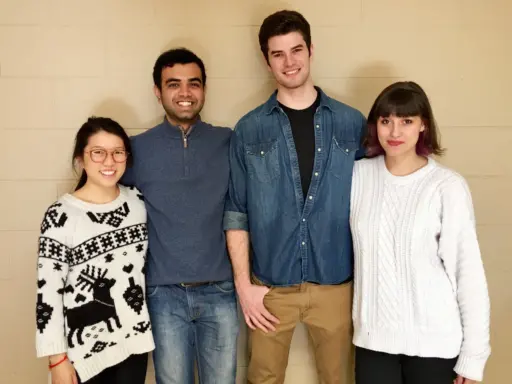An ordinary late-January day in Madison—with temperatures in the 30s and about an inch of fresh snow—became memorable when four engineering and computer science students at the University of Wisconsin-Madison received not one, but two pieces of good news: Their team was selected as a finalist in a design competition sponsored by the Human Factors and Ergonomics Society, and the students won their first-ever mini-grant from the Ira and Ineva Reilly Baldwin Wisconsin Idea Endowment at UW-Madison.
The reason for these accolades was Health Links, a smartphone app the students had worked on since September 2016 to help connect low-income Madisonians with community resources, such as food pantries, shelters and health centers. Based on a user’s geographic location and time of day, the app helps prioritize trips, minimize travel time and confirm business hours.
“The need for this kind of app is huge, especially since up to 70 percent of health outcomes have been attributed to influences outside traditional health care settings, such as social determinants of health,” says Nicole Werner, an assistant professor of industrial and systems engineering (ISyE) at UW-Madison and the students’ mentor.
The background of the Health Links team is diverse: Nadia Doutcheva is a first-year PhD student in the ISyE department; Michelle Tong is finishing her undergraduate degree in biomedical engineering in May 2017 and will pursue a master’s degree before enrolling in medical school; Tom Martell, a December 2016 graduate, just started his ISyE master’s program; and Ashish Shenoy will graduate with a master’s degree in computer sciences in May 2017.
 The Health Links team includes (from left to right): Michelle Tong, Ashish Shenoy, Tom Martell and Nadia Doutcheva.
The Health Links team includes (from left to right): Michelle Tong, Ashish Shenoy, Tom Martell and Nadia Doutcheva.
Through a shared interest in human factors engineering—a field that applies our knowledge of human capabilities and limitations to systems design—the students’ paths crossed at Werner’s lab, creating the impetus to enter the student competition and apply for the mini-grant.
The project idea arose at the Wingra Family Medical Center on Madison’s south side, where Tong was volunteering at the time. The clinic provides federally supported medical care to low-income residents, in partnership with the UW-Madison Department of Family Medicine and Community Health.
“I have always been interested in primary care and public health,” Tong says. “Making it easier for the Wingra clinic’s patients to connect with local resources for staying healthy and completing daily living tasks was an important incentive for developing the Health Links app.”
By interviewing the clinic’s social workers and several food pantry managers, the students assessed the currently available tools for locating community support services and identified areas for improvement.
The nonprofit organization Porchlight also was critical for the project’s success. It provides temporary housing services to Madison’s homeless population of more than 3,000 and has a history of collaborating with UW-Madison students. With Porchlight’s support, the team enlisted four volunteers—two “seeking” users in need of services and two “connecting” users, such as case managers, who help others find resources—to develop a Health Links prototype.
Applying the user-centered design techniques they had learned in class, the students outlined programming tasks for computer scientist Shenoy. Since smartphone ownership varies widely by income and age, they developed a mobile-enabled website that can be accessed from any internet browser—freely available at most public libraries—or downloaded as a smartphone app.
For Doutcheva, the project was something of an eye-opening experience. “I was very surprised at the disparity between the university campus and the rest of Madison,” she says. “Having just recently moved here, I wasn’t aware of the significant homeless population until we started this project.”
The main goal of Health Links is to match a user’s needs—for food, shelter, a shower, child care, transportation, job search assistance or skill-building—with community resources that can meet these needs at the time and place where they arise, and to provide Google Maps directions for reaching them. A future goal is to generate a “best fits” list based on previous searches of a demographically similar group of users.
For the student design competition, the team presented Health Links at the Human Factors and Ergonomics Society spring 2017 conference in New Orleans. Despite not winning first prize, they greatly valued the constructive feedback from academic and industry professionals. With the new Baldwin mini-grant, the students will expand Health Links to Milwaukee, a much larger city with different demographics that will require the support of new partner agencies.
The students are embracing these challenges. “This is the kind of work we hope to be doing for a living,” say Tong and Doutcheva. “Learning how to apply human factors engineering principles to a real-world problem is a valuable job skill as well as a rewarding experience.”